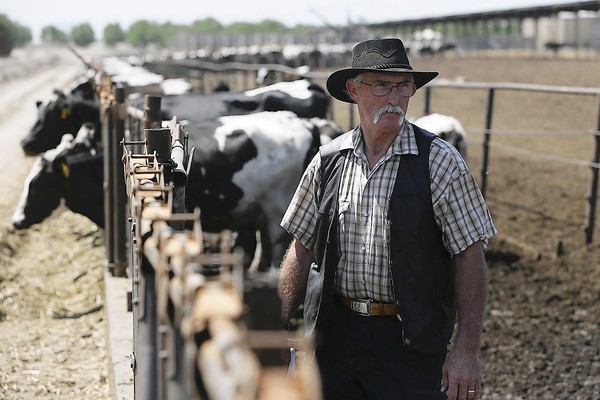
Dairyman Ron Koetsier tends to his cattle during feeding time at his dairy. Koetsier is in the process of restoring a 28-year-old power generating methane digester that has remained idle for about a decade. (Robert Gauthier/Los Angeles Times)
http://www.latimes.com/business/la-fi-dairy-digester-20130609,0,878419.story
By Ricardo Lopez, Los Angeles Times
Dairy farmer Ron Koetsier’s 1,200 cows produce roughly 90 tons of manure daily, and for the last three decades, he has tried unsuccessfully to turn the stinky dung into energy to power his 450-acre farm in Visalia.
He installed a nearly $1-million renewable energy system in 1985 that used the methane from manure to create electricity for his farm. In 2002, he replaced that system with newer technology, but he hit a snag when air-quality standards called for expensive retrofits to reduce air pollution; he eventually shut down the system in 2009.
In a few weeks, however, Koetsier’s renewable-energy efforts will get a reboot as a new company replaces his current system with one that is expected to satisfy strict air standards in the highly polluted San Joaquin Valley.
A decade or so ago, dozens of California dairy farmers built million-dollar systems called methane digesters that convert manure into power. Then, unexpected pollution problems, regulatory roadblocks and low rates of return killed most such digester systems, leaving only a handful in operation.
All that could be changing as renewable energy companies develop new ways of running digesters to boost profits. They’re improving technology to meet tough smog-control rules. At the same time, the state is trying out a streamlined permitting process to help remove costly regulatory hurdles.
Koetsier will be the first dairy farmer to install a digester under the state’s program. He said he is optimistic that this go-around — his third attempt to make a system work — will finally pay off.
After hearing of the technological and other advances, he decided to “give it another whirl,” Koetsier said.
State officials are pushing to reduce greenhouse gas emissions, and that is causing utilities to pursue more renewable energy sources. Experts say digesters show particular promise in California, the top dairy producing state with 1.8 million cows.
“If these digesters run properly, they can reduce odors associated with manure, stabilize nitrogen and have a number of environmental benefits,” said John Blue, climate change advisor for the California Environmental Protection Agency.
The systems “add to California’s goal of renewable power generation. We’d like to see dairy digesters as part of the mix.”
One California renewable energy company, CH4 Power Inc., said it plans to build more than 40 digester systems over the next year. It’s set to begin construction on its first digester on Koetsier’s dairy in the coming weeks. Other firms are expected to follow.
The challenge, however, may be trying to persuade weary dairy farmers to give digesters another try, especially after some tough years in the dairy industry.
Dairy farmers have plenty of manure lying around to convert to energy. A typical cow can produce as much as 150 pounds of dung daily. That presents a continuing challenge for farmers to dispose of waste and control the methane — a greenhouse gas — produced by decomposing manure.
Digesters seemed like the perfect solution only a few years ago. Manure is fed into a digester, which extracts methane from decomposing organic material, removes impurities and burns it to produce energy.
But many farmers ran afoul of air pollution regulations because their generators emitted nitrogen oxide, or NOx, a component of smog.
Retrofitting digesters with catalytic converters was expensive, costing about $150,000, and put additional strain on the engines that run the systems.
The current generation of digesters has improved technology that should alleviate that concern, experts said.
With those advances in mind, officials are trying to kick-start new projects by turning to a consolidated permitting program on the books since the mid-1990s but never used.
It took the collaboration by the state Department of Food and Agriculture, Cal/EPA, and local air and water quality boards to figure out how to permit new digesters.
The goal is to involve all the various permitting agencies in the beginning of the process to ensure there are no surprises later, Cal/EPA’s Blue said.


